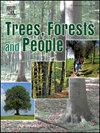The balance and potometric sap flow calibration approaches that rely on transpirational pull yield inconsistent estimates of transpiration
IF 2.7
Q1 FORESTRY
引用次数: 0
Abstract
Calibrating sap flow sensors enhances the accurate estimation of whole-tree transpiration is crucial for understanding forest water use and managing water resources, however calibration approaches that rely on different directional forces to move water through tree stems (push force vs transpirational pull) can result in different calibration coefficients. It remains unclear whether coefficients differ between approaches that use the same directional force. In this study, we compared transpiration estimates obtained from the balance and potometric sap flow calibration approaches using thermal dissipation (TD) sap flow sensors deployed in the same five white birch (Betula platyphylla) trees. We first conducted balance calibration using five intact potted trees, followed by cutting the materials to perform potometric calibration with rootless whole plants. We found that coefficients generated from one calibration approach serve as reliable predictors of reference transpiration when applied to TD measurements obtained from the other approach. Moreover, when applied to a growing season of TD sap flow measurements, balance coefficients yielded transpiration estimates 30 % higher (P < 0.05) than potometric calibrations. The results indicate that the potometric calibration is effective at predicting transpiration at low flow rates; however, as the proportion of high sap flow rates increases, it tends to underestimate transpiration estimates. Future research should focus on enhancing the accuracy of potometric calibration to improve its application in TD measurement studies. This enhancement will facilitate the precise estimation of whole-tree transpiration in the context of climate change, thereby elevating the quality of research in forestry science and promoting the sustainable management of water resources.
依靠蒸腾拉力的平衡和计量液流校准方法产生的蒸腾估算结果不一致
校准液流传感器可以提高对全树蒸腾的准确估计,这对于了解森林水资源利用和管理水资源至关重要,然而,依赖于不同方向力(推力与蒸腾拉力)使水在树干中移动的校准方法可能导致不同的校准系数。目前尚不清楚使用相同方向力的方法之间的系数是否不同。在这项研究中,我们使用热耗散(TD)液流传感器,在相同的五棵白桦树上,比较了从平衡和光度计液流校准方法获得的蒸腾估算值。我们首先使用5棵完整的盆栽树进行平衡校准,然后将材料切割,使用无根的整株树进行光电校准。我们发现,当将一种校准方法产生的系数应用于另一种方法获得的TD测量时,可以作为参考蒸腾的可靠预测因子。此外,当应用于TD液流测量的生长季节时,平衡系数产生的蒸腾估计值高出30% (P <;0.05)比光度计校准。结果表明,光度计定标能有效预测低流量下的蒸腾;然而,随着高SAP流量比例的增加,它倾向于低估蒸腾估计值。未来的研究重点应放在提高光度校准的精度上,以提高其在TD测量研究中的应用。这一改进将有助于在气候变化背景下精确估计全树蒸腾,从而提高林业科学研究的质量,促进水资源的可持续管理。
本文章由计算机程序翻译,如有差异,请以英文原文为准。
求助全文
约1分钟内获得全文
求助全文
来源期刊

Trees, Forests and People
Economics, Econometrics and Finance-Economics, Econometrics and Finance (miscellaneous)
CiteScore
4.30
自引率
7.40%
发文量
172
审稿时长
56 days
 求助内容:
求助内容: 应助结果提醒方式:
应助结果提醒方式:


